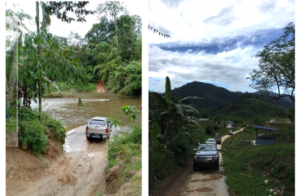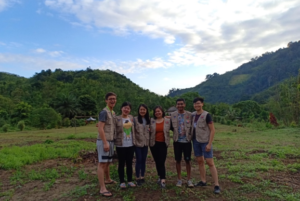
Medical Outreach Programme
Medical Outreach Programme 11/1/2019 – 14/1/2019
Article by Lim Hui Ern, January 24th
On the 11th of January 2019, six MAMSA members were given the opportunity to embark on a volunteering trip to Kampung Titom, Kampung Cerewes and Kampung Dayok in Pahang. The medical outreach programme was made possible thanks to FPMPAM (The Federation of Private Medical Practitioners’ Associations, Malaysia) and Raleigh KL.
These villages are located approximately 7 hours away from Kuala Lumpur and are made up of the Semai community, the second largest tribe in Peninsular Malaysia. The aim of the trip was to provide medical care for these communities and to allow us medical students to gain a deeper insight into the healthcare in rural areas of Malaysia.
Day 1

Figure 1: Our journey to the villages.

Figure 2: The village houses that we stayed in and the river we showered in.
After the flag off from Hospital Orang Asli Gombak, we embarked on a 7-hour journey to the villages. It was a memorable experience as we experienced for the first time, a long bumpy ride on the muddy road and river crossing in 4WD vehicles. Despite the long journey, the time was well spent as we interacted with many like-minded volunteers from various backgrounds.
Upon arrival, we were welcomed by the Ketua Kampung and the villagers. Although we were told that the villages have “basic living conditions”, we were still surprised to find that only one toilet was available and that it would be easier for everyone to shower in the river nearby. Having showered in the comfort of proper facilities for most of our lives, showering in the river was admittedly quite a challenge. Nevertheless, we embraced this experience.
Thanks to the recent solar project ran by Raleigh KL, some of the village houses were equipped with solar powered lighting. For travelling around the kampung, we still had to use torch lights to guide our way.
Living in urban settings, we are very privileged to have ease of access to sanitary facilities, clean water supply as well as electricity; so much so that many of us have taken them for granted. This experience also highlighted the need for more programmes that are targeted at improving the accessibility and quality of basic facilities in these villages.
Day 2
The next day marked the first day of our medical camp. Everyone worked swiftly to deliver boxes of medical supplies from our vehicles into the house. By 10am we were ready to welcome the patients. After registration, each patient’s height and weight were taken and this was followed by a measurement of their blood pressure and blood glucose level. The patients were subsequently ushered in for consultation with the general practitioners. Medications were dispensed at the pharmacy station. As skin diseases and musculoskeletal injuries caused by hard physical labour are extremely common, a skin specialist and an orthopaedic specialist were also present at the medical camp. For each day, six of us rotated between the different stations to offer assistance where necessary. By the afternoon, we managed to see approximately 70 patients at Kampung Titom.

Figure 3: Group photo at the end of the day.

Figure 4: Assisting the medical practitioners and the pharmacy station.
Day 3
The following day, we managed to serve approximately 120 patients at Kampung Cerewes. Later in the day, we arrived at our last village, Kampung Dayok. We were very grateful when we heard that the villagers had specially built several village houses over a short period of 2 weeks to welcome us volunteers.

Figure 5: The village houses built by the villages in 2 weeks’ time.
Day 4
Before we knew it, it was the last day of our medical camp. Like the day before, we saw approximately 120 patients at Kampung Dayok. A notable case I witnessed was that of a middle-aged male whose wife reported that he has been blind for several years. After examination, it was found that the patient has cataracts (a condition that causes the lens to be cloudy). The patient was then referred to Hospital Orang Asli Gombak for the cataract surgery. Extra care was given to ensure that there will be follow-up of this patient. It was distressing to know that due to a lack of medical facilities in the area, this patient was blind for several years when a cataract surgery, a relatively simple procedure that is readily available in many parts of Malaysia, could have made such a vast difference in his life.

Figure 6: Taking blood pressure and assisting in various stations.

Figure 7: Helping volunteers of Raleigh KL to install solar powered lighting.
We learnt that it is often difficult to get patients from the Orang Asli community or rural communities to consent to a hospital procedure due to their unfamiliarity with those outside their community and a lack of understanding of their condition, both of which impede them from getting the treatment that they need. Furthermore, it can be distressing for patients to be away from their hometown and out of their comfort zone, hence more effort is required to ensure that these patients are well-informed and have a good understanding of their condition and the treatment recommended.
Later in the day, we helped to install solar powered lighting with volunteers from Raleigh KL. It was fulfilling to see the houses light up after just hours of our effort.


Reflections on Volunteering Experience
Overall, the trip was an eye-opening experience for us. This experience highlighted the disparity in healthcare standards between rural and urban areas of Malaysia.
Lack of Accessibility
The lack of accessibility to these villages may deter or impede volunteers who wish to deliver any form of aid to the community. Furthermore, the muddy terrain can also pose a danger to the community especially during or after a rain which causes the road to become more slippery.
Building Trust with the Community
Building trust with the local community is an important aspect. It overcomes the unfamiliarity of the local community towards people who are not from the local community and allows them to be more open towards future programmes that aim to improve their living conditions. However, it should be noted that consistent and long-term effort is necessary for building and maintaining trust with the communities.
Limitations of One-time Effort
In comparison to the residents living in urban areas of Malaysia, those in the rural Orang Asli community do not have ease of access to medical services such as health check-ups and blood tests to monitor their health. Often, chronic conditions are left undiscovered and untreated thus undermining their quality of life. There are also limitations to a one-time effort, hence long-term and frequent health education programmes and screening programmes are necessary to improve the health of these communities.
Conclusion
During the trip, a fellow volunteer mentioned that many people often travel overseas to volunteer in less developed countries without realising that there are many marginalised communities within their home country that require help as well. This notion left a strong impression on me. I hope that through more of such initiatives, more individuals will become aware of the unmet medical needs of the rural or Orang Asli communities and will be encouraged to volunteer their time to provide aid to these communities.
We would like to thank FPMPAM for making this volunteering trip possible and for running such a successful medical outreach programme.
We would also like to thank Raleigh KL for their support in providing the manpower and in managing the various aspects of this outreach programme. The medical camp would not have been such a successful one without their help.
Lastly, we would like to thank all the volunteers who have volunteered their time for this medical outreach programme. Each and every one of you played a vital role in the medical outreach programme. Thank you for making the medical camp such a pleasant and memorable experience for all MAMSA members.
Written by Lim Hui Ern (On behalf of volunteers from MAMSA)

No Comments